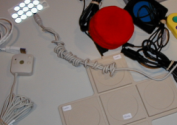 Assistive Keyboards, Mice, Switches, and other Mechanical Devices
Assistive Keyboards, Mice, Switches, and other Mechanical Devices 
COMP 190/290-039
Class #8 - 02/06/2003
Assistive Technology
Our guest speaker on February 6th, 2003 was A. Lynne Deese, a South Central Regional Consultant for the North Carolina Assistive Technology Program (NCATP). Ms. Deese obtained a Bachelor of Science in Special Education and a Master of Arts in Special/Correctional Education as well as a Disability Education certificate. She has an extensive background in education and technology.

NCATP is a division of Vocational Rehabilitation Services in the North Carolina Department of Health and Human Services. It is a state and federally funded program created to increase statewide access to assistive technology. Assistive technology, as defined on the NCATP website, is "any piece of equipment or device that is used to increase the independence of individuals with disabilities. These items can be commercially available, modified or customized for the user. They are 'tools' which individuals with disabilities use for living, learning, working and playing."
Ms. Deese spoke to us about the assistive technology (AT) services provided by NCATP and showed us many examples of the kinds of AT her office encourages the use of. Examples of these technologies include alternative keyboards and mice, joysticks, binary switches and customizable software for assisting with computer use.
Her presentation began with a reminder that assistive technology is important for everyone to think about, even if you don't currently have a disability. It is likely that at some point in our lives all of us will come to depend on assistive technology of some form. To drive this point home for our group, Ms. Deese reminded us of the prevalence of Repetitive Stress Injuries (RSI) in today's computer professionals and how assistive technology, in the form of alternative input devices like voice dictation software, is used to help those with RSI continue working in their careers. She also encouraged us to contact NCATP if we need assistance in dealing with RSI.
Much of the technology she discussed could be described as alternative forms of giving input to and getting output from computers and other devices. Also, some of the technology discussed was specifically designed for augmented communication. We review the technologies she discussed on two separate pages. The first is for the various physical, mechanical devices she showed like keyboards and switches, and the second is for the software she discussed.
 Assistive Keyboards, Mice, Switches, and other Mechanical Devices
Assistive Keyboards, Mice, Switches, and other Mechanical Devices
Other Information and Links